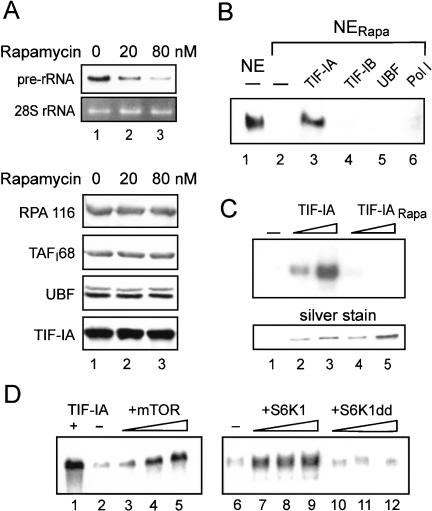Figure 1.
Rapamycin treatment impairs Pol I transcription by inactivating TIF-IA. (A) Northern blot. 45S pre-rRNA levels were monitored in 15 μg of total RNA from untreated Hela cells or cells that were treated with 20 or 80 nM rapamycin for 60 min. Western blots demonstrating that the amount of Pol I, TIF-IB/SL1, TIF-IA, and UBF remained unaffected by rapamycin treatment are shown below. (B) Complementation of transcriptional activity in nuclear extracts from rapamycin-treated cells. Transcription reactions contained nuclear extracts (30 μg) from untreated (NE) or rapamycin-treated (NERapa) FM3A cells. (Lanes 3–6) Fractions containing partially purified Pol I transcription factors (Schnapp and Grummt 1996) were added to NERapa-containing reactions. (C) TIF-IA from rapamycin-treated cells is transcriptionally inactive. Twenty nanograms and 40 ng of TIF-IA immunopurified from untreated (lanes 2,3) and rapamycin-treated NIH3T3 cells (lanes 4,5) were added to transcription reactions containing nuclear extracts (30 μg protein) from density-arrested cells. A silver-stained SDS–polyacrylamide gel showing the amount of TIF-IA added to the transcription assays is shown below. (D) Exogenous mTOR and S6K restore transcriptional activity in nuclear extracts from rapamycin-treated cells. Reactions were supplemented with 50 ng of TIF-IA (lane 1), 10, 20, and 30 ng of HA-mTOR (lanes 3–5), 100, 150, and 200 ng of GST–S6K1 (lanes 7–9) or the same amounts of GST–S6K1dd (lanes 10–12).

